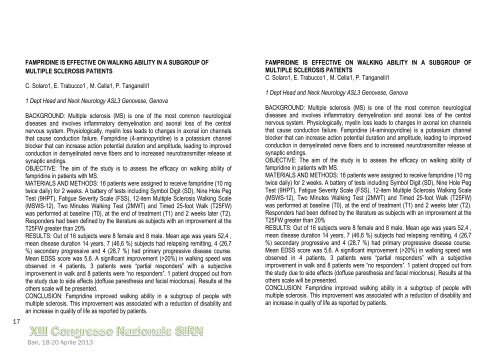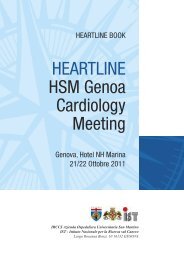cliccando qui - Aristea
cliccando qui - Aristea
cliccando qui - Aristea
Create successful ePaper yourself
Turn your PDF publications into a flip-book with our unique Google optimized e-Paper software.
17<br />
FAMPRIDINE IS EFFECTIVE ON WALKING ABILITY IN A SUBGROUP OF<br />
MULTIPLE SCLEROSIS PATIENTS<br />
C. Solaro1, E. Trabucco1 , M. Cella1, P. Tanganelli1<br />
1 Dept Head and Neck Neurology ASL3 Genovese, Genova<br />
BACKGROUND: Multiple sclerosis (MS) is one of the most common neurological<br />
diseases and involves inflammatory demyelination and axonal loss of the central<br />
nervous system. Physiologically, myelin loss leads to changes in axonal ion channels<br />
that cause conduction failure. Fampridine (4-aminopyridine) is a potassium channel<br />
blocker that can increase action potential duration and amplitude, leading to improved<br />
conduction in demyelinated nerve fibers and to increased neurotransmitter release at<br />
synaptic endings.<br />
OBJECTIVE: The aim of the study is to assess the efficacy on walking ability of<br />
fampridine in patients with MS.<br />
MATERIALS AND METHODS: 16 patients were assigned to receive fampridine (10 mg<br />
twice daily) for 2 weeks. A battery of tests including Symbol Digit (SD), Nine Hole Peg<br />
Test (9HPT), Fatigue Severity Scale (FSS), 12-item Multiple Sclerosis Walking Scale<br />
(MSWS-12), Two Minutes Walking Test (2MWT) and Timed 25-foot Walk (T25FW)<br />
was performed at baseline (T0), at the end of treatment (T1) and 2 weeks later (T2).<br />
Responders had been defined by the literature as subjects with an improvement at the<br />
T25FW greater than 20%<br />
RESULTS: Out of 16 subjects were 8 female and 8 male. Mean age was years 52,4 ,<br />
mean disease duration 14 years, 7 (46,6 %) subjects had relapsing remitting, 4 (26,7<br />
%) secondary progressive and 4 (28,7 %) had primary progressive disease course.<br />
Mean EDSS score was 5,6. A significant improvement (>20%) in walking speed was<br />
observed in 4 patients, 3 patients were “partial responders” with a subjective<br />
improvement in walk and 8 patients were “no responders”. 1 patient dropped out from<br />
the study due to side effects (doffuse paresthesia and facial mioclonus). Results at the<br />
others scale will be presented.<br />
CONCLUSION: Fampridine improved walking ability in a subgroup of people with<br />
multiple sclerosis. This improvement was associated with a reduction of disability and<br />
an increase in quality of life as reported by patients.<br />
Bari, 18-20 Aprile 2013<br />
FAMPRIDINE IS EFFECTIVE ON WALKING ABILITY IN A SUBGROUP OF<br />
MULTIPLE SCLEROSIS PATIENTS<br />
C. Solaro1, E. Trabucco1 , M. Cella1, P. Tanganelli1<br />
1 Dept Head and Neck Neurology ASL3 Genovese, Genova<br />
BACKGROUND: Multiple sclerosis (MS) is one of the most common neurological<br />
diseases and involves inflammatory demyelination and axonal loss of the central<br />
nervous system. Physiologically, myelin loss leads to changes in axonal ion channels<br />
that cause conduction failure. Fampridine (4-aminopyridine) is a potassium channel<br />
blocker that can increase action potential duration and amplitude, leading to improved<br />
conduction in demyelinated nerve fibers and to increased neurotransmitter release at<br />
synaptic endings.<br />
OBJECTIVE: The aim of the study is to assess the efficacy on walking ability of<br />
fampridine in patients with MS.<br />
MATERIALS AND METHODS: 16 patients were assigned to receive fampridine (10 mg<br />
twice daily) for 2 weeks. A battery of tests including Symbol Digit (SD), Nine Hole Peg<br />
Test (9HPT), Fatigue Severity Scale (FSS), 12-item Multiple Sclerosis Walking Scale<br />
(MSWS-12), Two Minutes Walking Test (2MWT) and Timed 25-foot Walk (T25FW)<br />
was performed at baseline (T0), at the end of treatment (T1) and 2 weeks later (T2).<br />
Responders had been defined by the literature as subjects with an improvement at the<br />
T25FW greater than 20%<br />
RESULTS: Out of 16 subjects were 8 female and 8 male. Mean age was years 52,4 ,<br />
mean disease duration 14 years, 7 (46,6 %) subjects had relapsing remitting, 4 (26,7<br />
%) secondary progressive and 4 (28,7 %) had primary progressive disease course.<br />
Mean EDSS score was 5,6. A significant improvement (>20%) in walking speed was<br />
observed in 4 patients, 3 patients were “partial responders” with a subjective<br />
improvement in walk and 8 patients were “no responders”. 1 patient dropped out from<br />
the study due to side effects (doffuse paresthesia and facial mioclonus). Results at the<br />
others scale will be presented.<br />
CONCLUSION: Fampridine improved walking ability in a subgroup of people with<br />
multiple sclerosis. This improvement was associated with a reduction of disability and<br />
an increase in quality of life as reported by patients.





